|
|
Toyota Mirai
|
 |
|
|
Debut: 2015
Maker: Toyota
Predecessor:
No
|
|
|
|
Published
on 23
Sep 2015
|
All rights reserved.
|
|
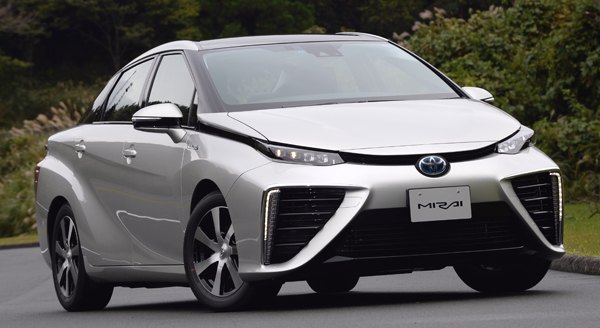
|
If I sell you a car
at the same money as a BMW 730d, you must expect something premium. But
what if the car looks like a pig and goes like a turtle? and it weighs
1850 kg yet is propelled by only 150 horsepower? and the interior is
neither luxury nor especially spacious? I guess you must say I am
crazy. Yes, putting a hydrogen car into mass production is the craziest
thing right now in the automotive industry. Then again, Toyota did the
same thing with Prius in 1997. Every radical technology starts with
high costs and limited practicality.
For many years, Hydrogen fuel cell has been tipped to be the technology
of the future. A hydrogen fuel cell converts hydrogen fuel and oxygen
(from intake air) into electricity for motivating the car, and the only
by-product is water vapour. It goes without saying that the main
advantage is no air pollution on road, although the industry producing
hydrogen could be less green and efficient (we shall see more on that
later). A few years ago, Honda was the first to put hydrogen fuel cell
cars to commercial use with its FCX
Clarity, but that car was more a small-scale experiment. It was
leased rather sold to customers because the technology was not matured
enough. This means the first production hydrogen fuel cell car has to
be Toyota Mirai, whose name translates to “Future” in Japanese.
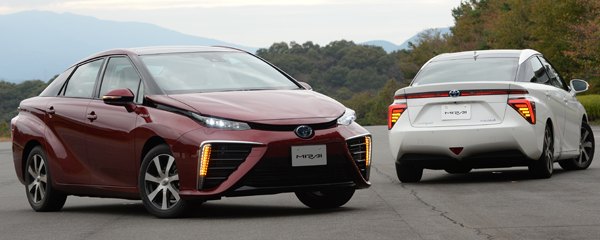
|
Futuristic or not, the Mirai looks really weird and ugly. Such an
unpleasant appearance is partly due to its unusual mechanical layout
but also thanks to the strange taste of its designers and Akio Toyoda.
However, the technology underneath its sheet metal is undoubtedly
advanced. Previously, the major hurdle preventing hydrogen fuel cell
cars from mass production was high production costs. To overcome this,
Mirai is designed to take the platform of Lexus HS250h and many
components, such as motor, battery and power electronics, come from the
existing hybrid cars of Toyota. This greatly enhances economy of scale
while slashes development costs.
The Mirai is unusually tall at 1535 mm because its fuel cell stack and
hydrogen tanks are stored underneath the front and rear seats plus boot
floor respectively. This tallness and the round profile belie the size
of the car – believe or not, it is actually as long and as wide as a
BMW 5-Series! The fuel cell stack is quite compact and power dense. It
comprises of 370 cells. Each cell employs polymer membrane and
3-dimensional mesh air channels to draw air and hydrogen gas together
and react, generating electricity across the electrodes. The DC voltage
is then boosted to 650V, inverted to AC and feed the propulsion motor
through a buffer, i.e. a NiMH battery which is placed above the second
hydrogen tank in the boot. The synchronous motor is located at the
front axle and drives the front wheels. Its output is rated at 151 hp
(SAE) or 154 hp (JIS), while maximum torque is 247 lbft. As a result,
performance is modest. Toyota quotes 111 mph top speed and 0-60 mph in
9 seconds, about the same as a Prius. A recent test by Car and Driver
found it slower still.
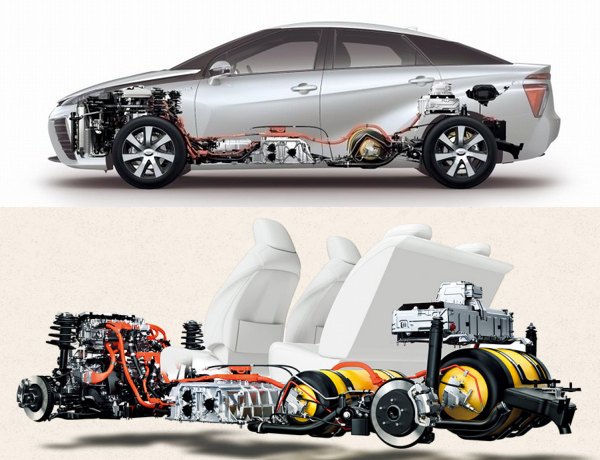
|
Apart from the fuel cell stack, the high-pressure hydrogen fuel tanks
are also state of the art. They are made of 3 layers – the inner is
plastic seal, the middle layer is super-strong carbon-fiber reinforced
plastics while the outer layer is impact absorbing glass-fiber
reinforced plastics. They store the compressed hydrogen gas at 700 bar
and protect against collision. The cylindrical tanks occupy a lot of
space yet they carry only 5 kg of hydrogen. However, since hydrogen is
more energy-dense than gasoline, 5 kg is already good for a range of
300 miles in typical US and EU measurement, or 400 miles (650 km) in
Japan. That is the biggest advantage over current generation of
electric cars.
Moreover, the Mirai can be refilled at hydrogen stations like
conventional cars, taking minutes rather than hours. That said, such
refilling stations are not going to be a common sight in the
foreseeable future. It might take a decade or two to build the
infrastructure, assuming there will be sufficient demand to lure the
energy industry. In my opinion, this could be the decisive cause if the
Mirai fails to repeat the successful story of Prius.
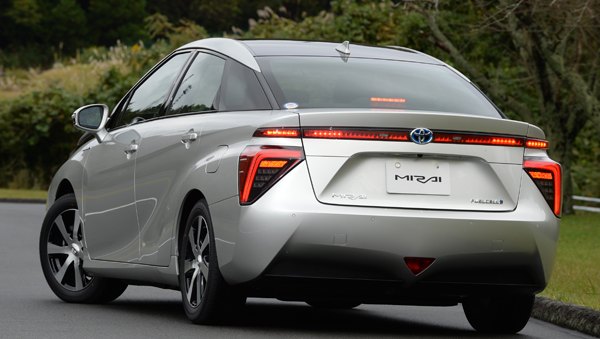
|
Mirai is not as bulky to drive as its looks or weight suggested. Like
many EVs, its heavy mechanicals are all mounted close the floor thus
the center of gravity is low, despite of the high-sitting occupants. As
a result, it steers and controls its body roll better than expected.
The Michelin 215/35R17 tires provide adequate grip. The ride is
composed in urban driving. Of course, don’t expect a lot of
communication from the front wheels or an interactive handling. It is
designed to be a comfortable and energy efficient car in the first
hand. You had better to set back and enjoy its smooth, almost silent
progress. The power it offers is adequate at lower speeds but at no
point it feels quick.
The lack of hot exhaust pipes means the Mirai can use a full-length
undertray to cover its bottom and result in a drag coefficient of 0.29,
which is pretty good considering the huge intakes at its nose generate
extra drag. These intakes are necessary to feed and cool the fuel cell
stack.
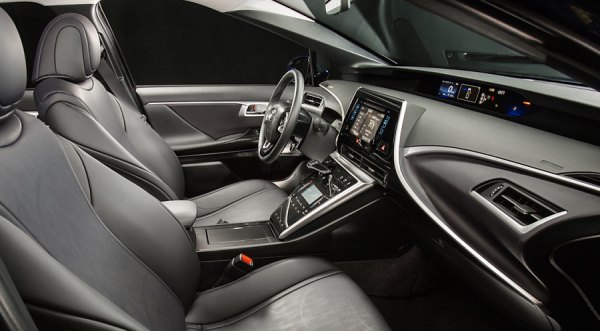
|
Inside, the Mirai looks like a Prius-Plus rather than a Lexus in terms
of build quality and equipment. The dashboard architecture is MPV-like
and radically, if not tastefully styled. All occupants sit MPV-high as
a result of its mechanical packaging. The amount of cabin room is close
to Camry, but the rear seat is restricted to two as it is split by a
center console/armrest. There’s no pass-through to the boot because of
the presence of battery pack behind the rear seats. It is not as
practical as a conventional D-segment car.
Coupling to the very high price, it is not going to be a sales hit in
the first attempt. All Toyota wants is to gradually improve it,
lowering its production costs, lifting its performance and practicality
in the following years. If it goes according to plan, maybe it will be
just as popular as Prius in the second or third generation. For now,
the production plan is conservative. Some 700 cars will be built within
this year to satisfy mostly the domestic market (plus a small portion
to US and Europe). In the next two years the production will step up to
around 2000 units and 3000 units respectively. To sweeten the deal,
buyers will be offered with free hydrogen refill in the first 3 years.
Still, without a wide network of refilling stations, I think hydrogen
fuel cell cars will be difficult to compete with the fast-rising
electric cars.
|
Verdict:   |
| Published
on 23
Sep
2015 |
All rights reserved.
|
|
How green is hydrogen fuel cell?
|
|
Hydrogen fuel cell cars do
not produce greenhouse gas, but the industry that supplies hydrogen
fuel does. Obviously, the emission level depends very much on the way
hydrogen is produced. If it is produced by electrolysis of water, and
the electricity comes from clean sources like wind or hydropower, the
emission should be close to zero. If the electricity comes from coal
power, then the emission could be very high.
In reality, most of the world’s hydrogen is produced by reforming
natural gas (whose primary ingredient is methane). This process mixes
natural gas and steam at very high temperature (700-1000°C) and
converts them to H2 and CO2.
This is the most cost effective way to produce hydrogen, but it emits
greenhouse gas and takes a lot of energy, which indirectly produces
more greenhouse gas. Toyota admits the hydrogen used by Mirai is most
likely produced in this way.
So how green is the fuel cell when the hydrogen is produced from
natural gas? It takes a comprehensive research. In 2014, European Joint
Research Centre (JRC) was committed by EU to produce a report on
emissions of various green car technologies. It used “well-to-wheel”
emission as indicator, which covers the emissions resulted in the whole
process, from oil production, hydrogen production, transportation and
storage of fuel all the way to the generation of propulsion by the
vehicle. Based on development trend of technologies, it forecasted the
well-to-wheel greenhouse gas emissions for vehicles beyond year 2020:
- Plug-in hybrid vehicles, charged by
EU-mix electricity*: 74 g/km
- Battery electric vehicles, charged by
EU-mix electricity*: 57 g/km
- Fuel cell vehicles, hydrogen produced
by electrolysis with EU-mix electricity*: >120 g/km
- Fuel cell vehicles, hydrogen produced
by natural gas reform: 55-75 g/km depending on production location,
transportation and storage methods.
As seen, fuel cell cars are no greener than battery electric
cars, and barely better than PHEVs like Chevrolet Volt. Moreover, as
the world’s electricity mixture is shifting from fossil fuel to
renewable and nuclear power, the well-to-wheel emissions of EVs and
PHEVs are likely to fall faster than the case of FCVs in the next 2
decades. In addition to the lower construction and maintenance costs of
recharging stations, no wonder Tesla’s Elon Musk believes governments
and energy industry will put their money on recharging stations rather
than hydrogen refilling stations. Without a widely available refilling
network, the development of fuel cell cars will be seriously limited.
Mirai or Tesla, which one will be the future? We shall see soon.
* EU-mix electricity: the average composition of electricity generation
in EU, including coal, natural gas, nuclear, wind and solar etc.
|
|
|
|
|
|
|
|
|
|
|
Mirai
|
2015
|
| Front-engined,
FWD |
| Steel monocoque |
| Mainly steel |
| 4890 / 1815 / 1535 mm |
| 2780 mm |
Hydrogen fuel cell + electric motor
|
| - |
-
|
| - |
| - |
151 hp (Fuel cell: 153 hp)
|
247 lbft
|
1-speed
|
F: strut
R: double-wishbones
|
-
|
| 215/35R17 |
1850 kg
|
111 mph (c) / 108 mph*
|
9.0 (c) / 9.4* / 8.9* / 10.1**
|
34.2* / 31.7* / 36.5**
|
|
|
|
|
|
|
|
Performance
tested by: *C&D, **Autocar
|
|
|
|
|
|
|
|
|
Copyright©
1997-2015
by Mark Wan @ AutoZine
|
|